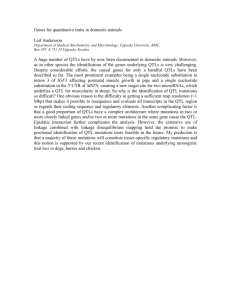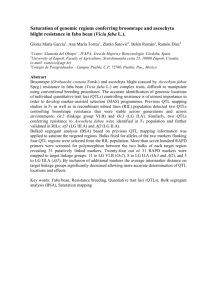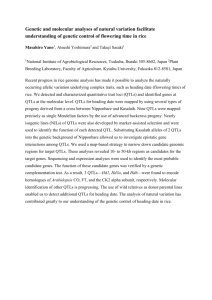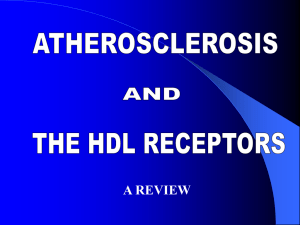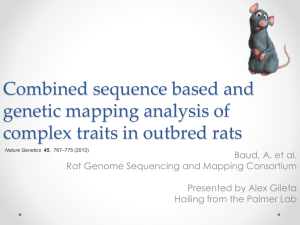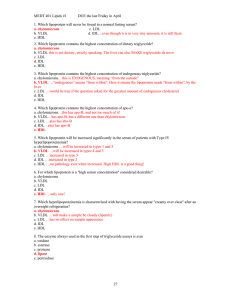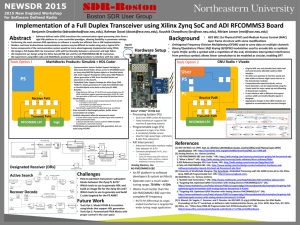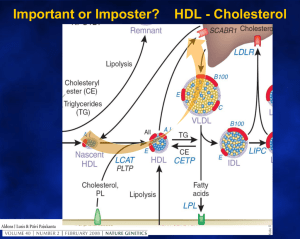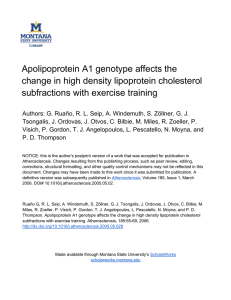QTL Presentation
advertisement
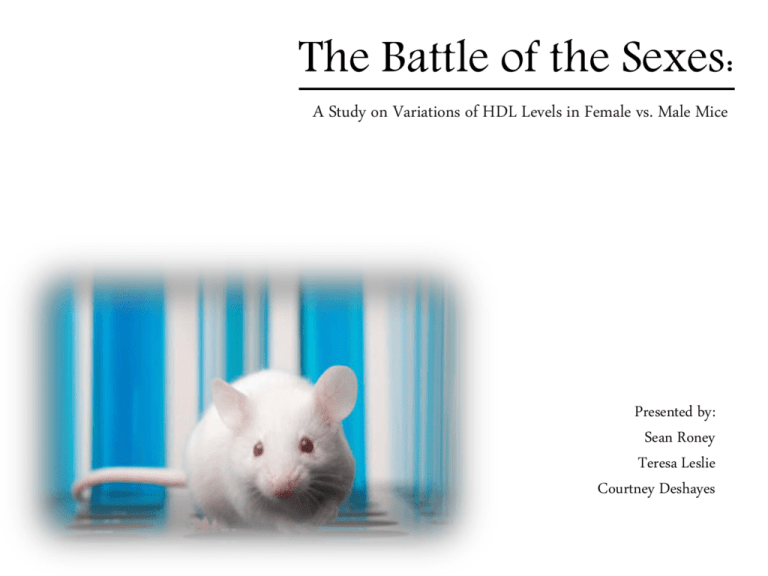
The Battle of the Sexes: A Study on Variations of HDL Levels in Female vs. Male Mice Presented by: Sean Roney Teresa Leslie Courtney Deshayes What in the World is QTL• QTL- Quantitative Trait Locus • 2+ strains, phenotypic data vs. genotypic data • Summarizes action, interaction, number, and precise location of regions • Can compare with knockout and over expression The Basic Background- HDL- helps prevent cardiovascular disease HDL vs. LDL Cardiovascular diseasehardening of the arteries Experimental Factors• Same environment, variation in plasma lipoprotein concentration – Genetic Background • Nutrition, “safe” high-fat diet – Similar to humans • Male vs. Female – Is sex a factor? – Compared two studies Actual Experiment• Two Studies – 330 male R111x129 – 294 female B6x129 • Length – 12 weeks (male) and 14 weeks (female) • Plasma lipoprotein levels (HDL) in mice Initial HDL LevelsSex: n Plasma HDL mg/dl Female 294 81 +/- 1 Male 330 143 +/- 2 •Males higher HDL levels, testosterone -- Difference of about 62 mg/dl •Comparison- human females higher than males QTL Analysis- Female QTLs ↓ Male QTLs ↑ Table of Data• LOD scores range from 2.6-9.8 • Only HDL QTLs compared Sex: # Sig QTLs Male 3 Female 6 Hdlq5 Hdlq14 Hdlq15 Hdlq16 X X X X Hdlq17 Hdlq18 X X X X Hdlq19 X Results• Male- Hdlq5 candidate gene APOA2 • Female- Hdlq15 (interacts with Hdlq 14 and 19) APOA2 • Information relatable to humans • Confirmed with knockout and over expression methods Other Findings• Female– Hdlq18 is novel – Hdlq16 leads to gene involved with lipoprotein metabolism • Both– Hdlq17 APOA1/APOC3/APOA4 – Male outside the 95% CI Conclusion• Males and females have some comparable data • Females have several QTLs that males do not, investigate further • Information is relatable to humans References• Malcolm A. Lyons, Ron Korstanje, Renhua Li, Kenneth A. Walsh, Gary A. Churchill, Martin C. Carey, and Beverly Paigen. “Genetic contributors to lipoprotein cholesterol levels in an intercross of 129S1/SvImJ and RIIIS/J inbred mice.” Physiol Genomics 17:114-121, 2004. First published Feb 10, 2004. • Ishimori, Naoki, Renhua Li, Peter M. Kelmenson, Ron Korstanje, Kenneth A. Walsh, Gary A. Churchill, Kristina Forsman-Semb, and Beverly Paigen. "Quantitative Trait Loci Analysis for Plasma HDL-Cholesterol Concentrations and Atherosclerosis Susceptibility Between Inbred Mouse Strains C57BL/6J and 129S1/SvImJ." Arteriosclerosis, Thrombosis, and Vascular Biology 24 (2003): 161-66. • Miles, C. & Wayne, M. (2008) Quantitative trait locus (QTL) analysis. Nature Education 1(1) • Some homology data for this paper were retrieved from the Mouse Genome Database (MGD), Mouse Genome Informatics, The Jackson Laboratory, Bar Harbor, Maine. World Wide Web (URL: http://www.informatics.jax.org). (June 9, 2010) A Monumental Thanks to• Randy Von Smith, PhD • Tobias Beckwith • Brook Milligan, PhD • Jackson Laboratories • NIH- RISE Program
